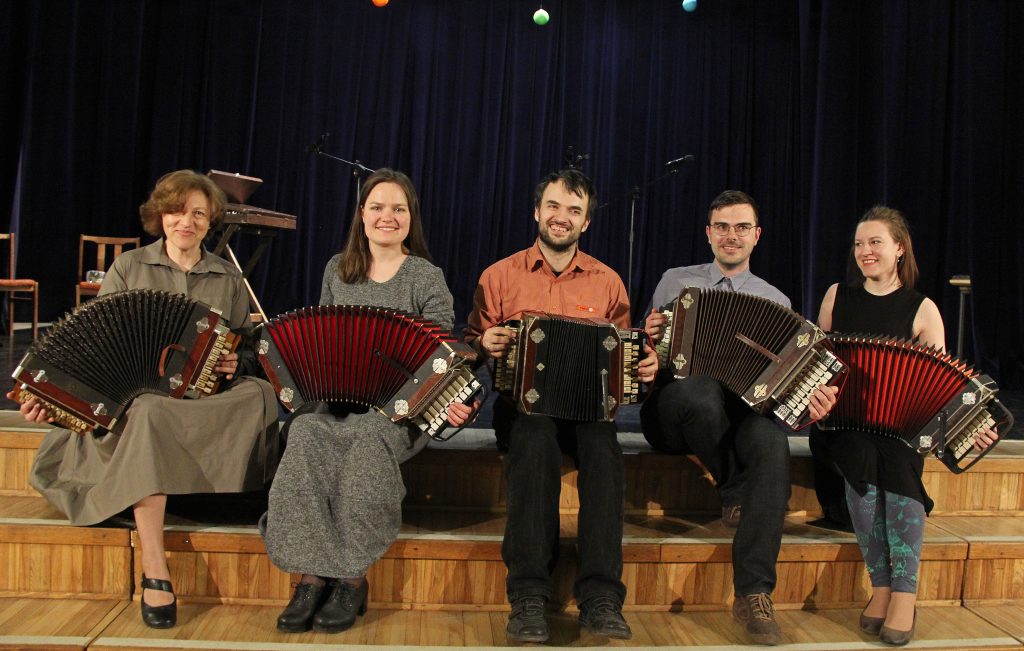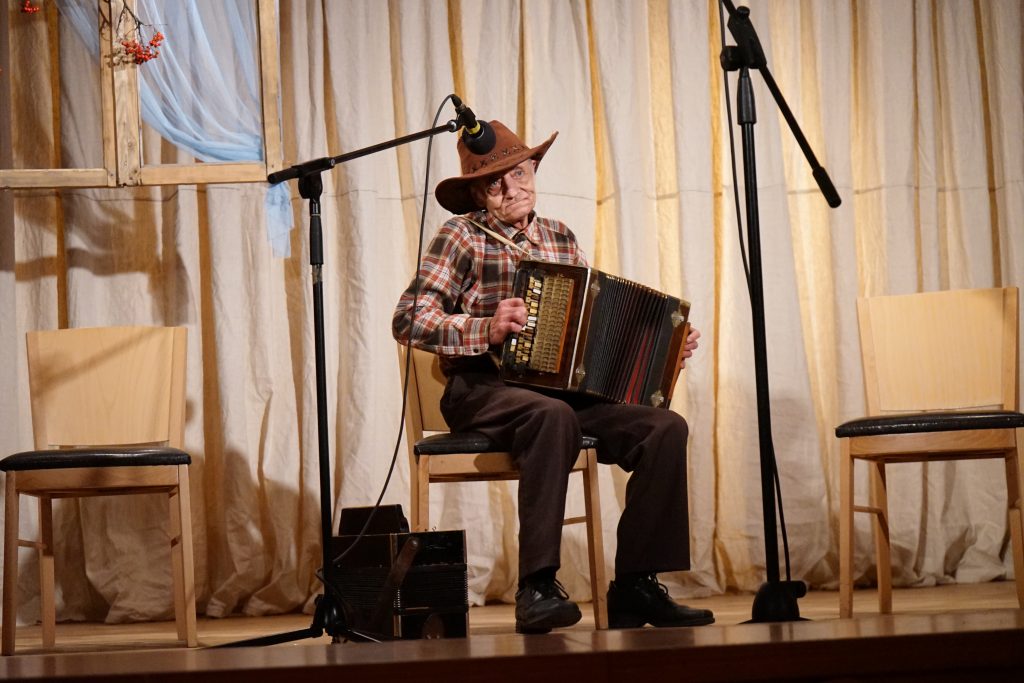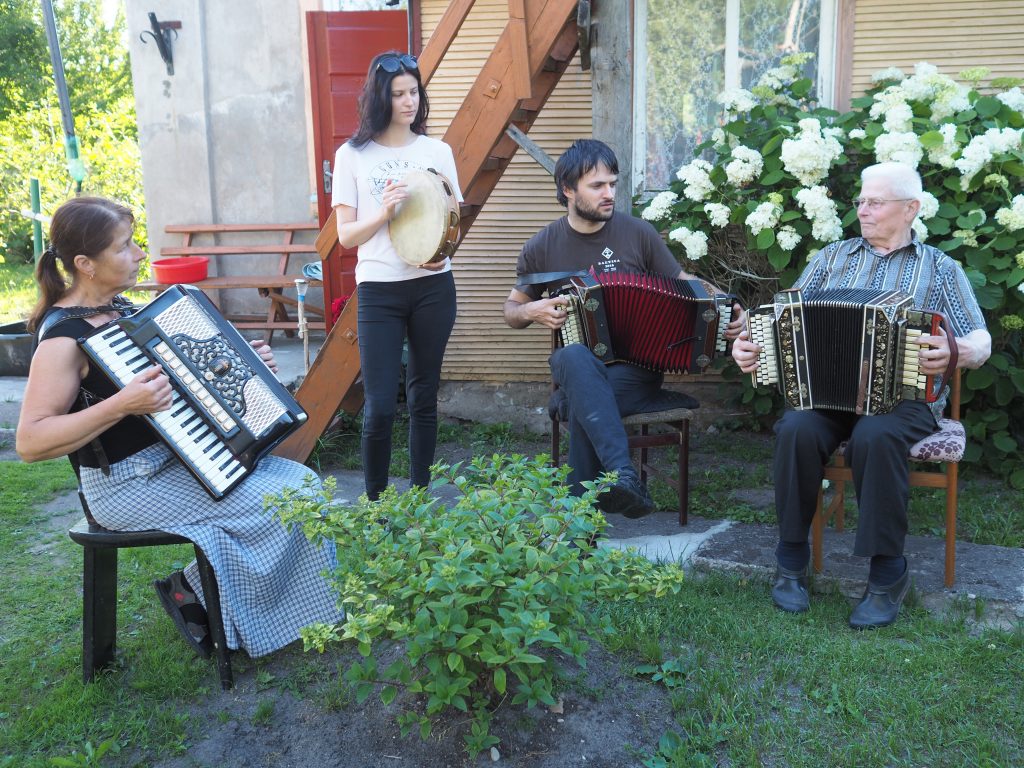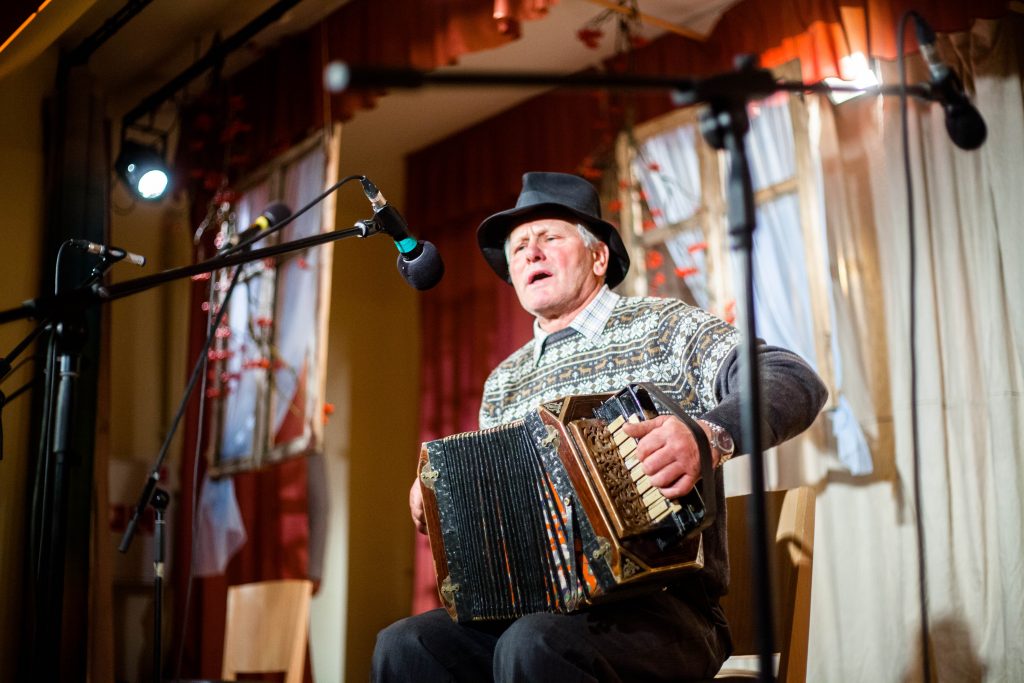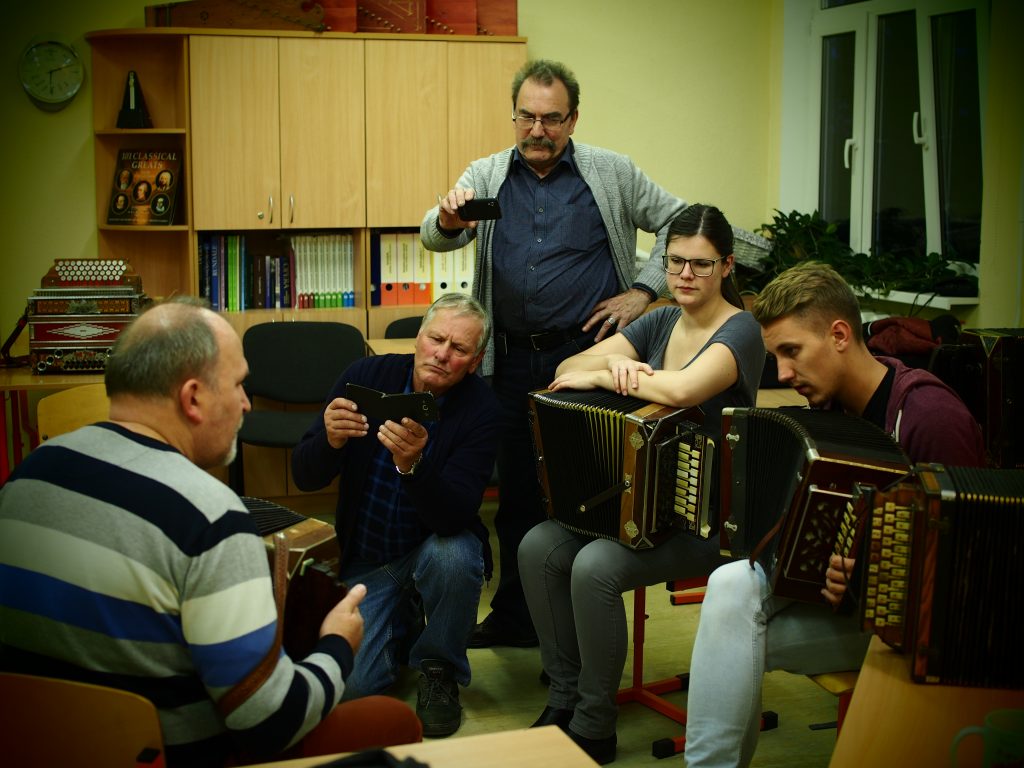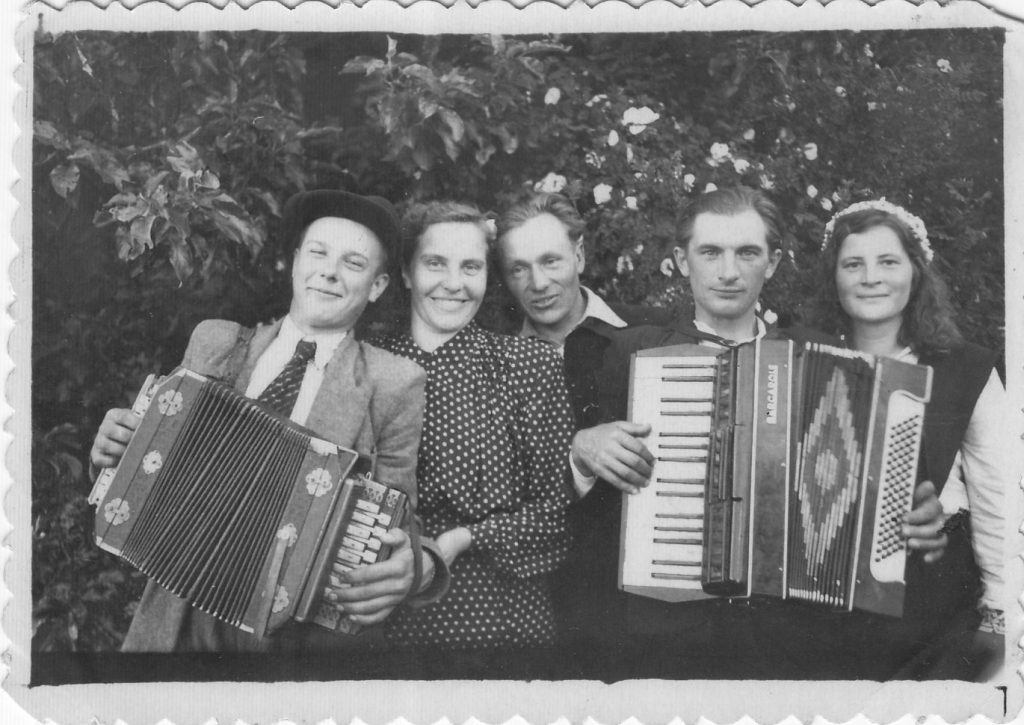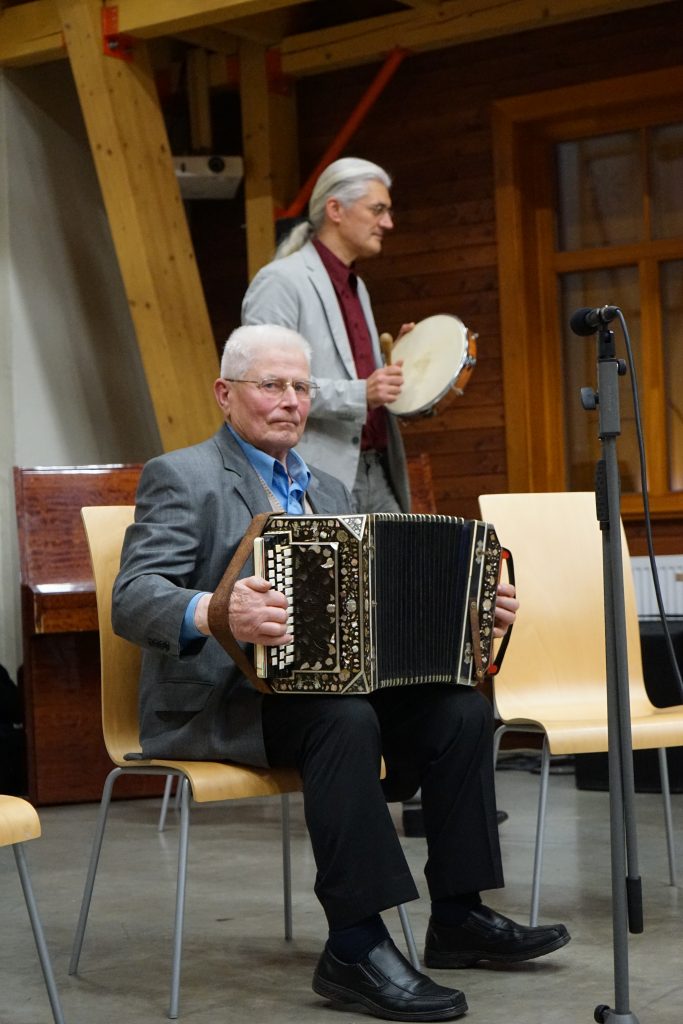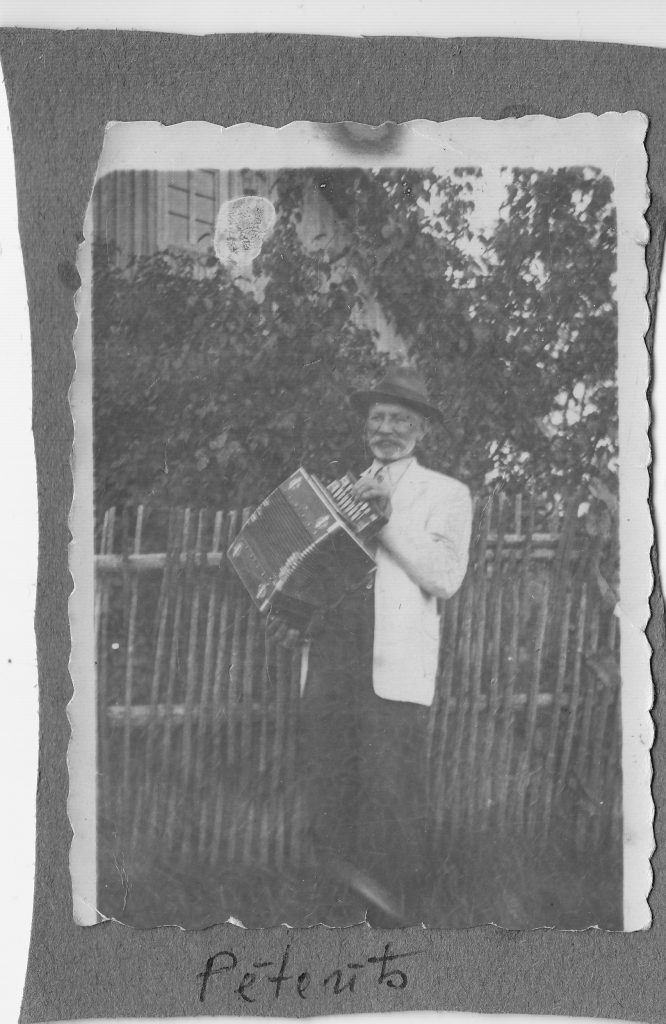Author:
Ilona Dzērve-Tālute
Music/performing arts
Title
The Petersburg garmon performance traditions (2018)
Pēterburģene, petrogradka, Pīterpiļs garmane, trīsrindu (trijrindu) ermoņikas, trīsrindene, trjohrjadka, harmonika, garmoška etc.
Geography
Historically, mainly Latgale. The St. Petersburg garmon is an instrument belonging to a wider cultural region – it was spread in the northwest of Russia, Carelia, the north-west of Belarus, the Seti lands, Aukštaitija in Lithuania; in the territory of Latvia – Latgale and episodically in Northern Vidzeme.
Despite the diminished practice of playing the instrument, it is still well known in the historical area of distribution and is regarded as a significant part of Latgale culture.
The St. Petersburg garmon and the stories about playing it are included in the exhibitions of nearly all Latgale regional history museums and specialist retellings.
The element is important for individuals and groups associated with the cultural traditions of the region. It is important for both the players themselves and those who do not play themselves (for example, the families of former players) or play any other instrument, but can describe the place of the garmon in cultural traditions, its sound quality, and the masterful skill of its players.
The study and promotion of the tradition are now taken over by members of folklore groups, ethnomusicology specialists and enthusiasts who form a new skill bearer community(s), both in cooperation and communication between themselves and within the framework of their own interest group.
In the case of the St. Petersburg garmon, it is important that several of these communities are forming in the area of historical spread of the instrument, therefore while preserving some inheritance and succession.
Significance in community life
The living tradition of playing the instrument is now better preserved in Lithuania. In Latvia and Belarus, it is maintained by individual musicians with playing skills. The tradition should be considered in the context of broader cultural history, and the cross-border cooperation based on the common tradition should be developed, including the exploration, promotion and preservation of the Petersburg garmon.
In the second half of the 20th century, as the popular contemporary musical forms changed, as well as due to the the influence of the dismissive Soviet cultural policy, the instrument performance was marginalized, the building and repair possibilities of the instrument died out; the musicians turned to the more accessible accordion and uni-tone (a key produces the same sound while the garmon is pushed and pulled) two-line garmon (hromka).
Despite this, individual performers continued to play the St. Petersburg garmon, preserving the instrument-specific playing technique, repertoire and manner or music-making. Similarly, many families even after the cessation of musical practices kept their ancestral instruments and anecdotes about the musicians' lives.
Activities
Passing on and transferring skills
History
The St. Petersburg garmon is a harmonica of German-type design, created and mass-produced in the St. Petersburg garmon workshops.
The garmon is small and visually appealing with rectangular bone or plastic keys, often adorned with wooden inlay work. The main body has chamfered corners which usually have mother of pearl inlay work featuring a lyre or a butterfly. Due to railroad traffic, the St. Petersburg garmon became the dominant bellows instrument in Latgale during the 19th century, and it not only strongly influenced the musical traditions of the region but became one of the region’s cultural identity signifiers.
St. Petersburg garmon were an integral part of the musical accompaniment at various social events – social gatherings, balls and weddings, masquerades, etc.
The instrument has a rich timbre and is at the same time soft and sufficiently loud. Musically, it fulfills multiple functions at the same time – it is used as the melody, chord accompaniment and to an extent also rhythmic instrument. It is comfortable to use and well-suited for long playing sessions. The garmon was played both solo and along with other instruments, most frequently a fiddle, zither, mandolin, and percussion. The main repertoire consists of every-day music, especially dance music: polkas, waltzes, foxtrots, quadrilles, krakowiaks, pas d'espagnes, vengerkas etc.
Among families and friends, accompaniments to songs were played. In a performance of a skilled musician, the melodies get adorned with small virtuosso melodic and rhythmic embellishments that create the musician’s individual style. Individual musicians are known to have perfected the duplication of the melody in the bass lines that is characteristic of the St. Petersburg garmon, but has not been recorded in any other type of garmon.
When this garmon was no longer produced in Russia, the local masters took over the function (there are still few records on this, but the instruments remain), and due to this, the living tradition of playing the instrument continued until the 60–70s of the 20th century.
At present, in its initial distribution region the instrument is well recognized in a passive tradition, but only a few older-generation players have maintained a good level of the performance skill. Latvian folklore researchers have only recently started to show interest in the garmon – for many years researchers did not pay attention to garmons because they were not considered to be a sufficiently old and research-worthy instrument. Therefore, unlike neighbouring countries, in Latvia the traditions of garmon performance are still poorly documented and we still have very little published material on these instruments.
In light of the long cessation of the normal functioning of the tradition and the situation where many forms of traditional culture have lost their original functions, playing the St. Petersburg garmon is no longer perceived as an integral part of the traditional music culture. It is shown on the stage in traditional culture festivals and concerts. As the number and skill of new players is growing, the St. Petersburg garmon is expected to be included more in folklore and folk music groups and events (dances, balls, concerts, festivals, musical accompaniment of events, etc.) equivalent to other traditional musical instruments, ideally maintaining the link to Latgalian culture.
Additional Information
The playing technique of the St. Petersburg garmon does not differ from other traditional entertainment music instruments.
It is linked to all of the traditional occasions for musicmaking (family honors, balls, evening gatherings, etc.) where garmon playing is permitted or desirable, as well as knowing the musical repertoire corresponding to each music playing occasion.
For example, a wedding musician had to know how to play at least ten different wedding marches that were to be performed during certain moments of the wedding celebration.
Masters
At the moment, the bearers of St. Petersburg garmon tradition are the few remaining old masters who still maintain their skills at a presentable level and are willing to share them.
The most notable players are:
• Alberts Mednis (b. 1936 in Blauzgova, Baltinava municipality – 2020);
• Pēteris Namavīrs (b. 1927 in Indra – 2019);
• Normunds Tušinskis (b. 1947 in exile in Siberia).
A second group of traditions bearers is formed by musicians who have acquired the instrument performance through education, continue to maintain it and actively practice it:
• Oskars Patjanko;
• Pēteris Justs;
• Ilona Dzērve-Tālute;
• Austra Eriņa;
• Irēna Skrinda;
• Sanita Sprūža.
Equally important for the preservation of the tradition are the persons who have learned and perform the repair and maintenance of instruments – Raitis Sondors, Oskars Patjanko, Jānis Meņģelis.
Agencies and institutions
• Museum of Latgale cultural history;
• Latvian Ethnographic Open-Air Museum;
• Jāzeps Vītols Latvian Academy of Music.
These institutions keep important information on the traditions of garmon performance, including the performance recordings and musical instruments.
The National Culture Centre of Latvia, which is responsible for the implementation of cultural policy, including the organisation of traditional cultural processes and educational events, as well as the organisation of activities aimed at the preservation of intangible cultural heritage.
The association “Skaņumāja”, prepared and promotes the ICH entry application, provides educational and promotion measures.
The society “Riga Folk music society” ensures repair and manufacture of instruments, as well as promotional activities.
Consolidation
A number of activities have been performed during the reporting period for promotion, preservation and maintenance of the element.
PROMOTING TRADITION TO THE GENERAL PUBLIC
• The instrument is viewable and displayed in “Skaņumāja” traditional instrument exposure. (Completion of the municipality of Ogre – EUR 1000, LEADER funding EUR 9859, funding of the NGO programme of the CCF);
• Alberts Mednis and Ilona Dzērve performed at the 2018 Baltica festival concert. (LNKC total event funding - €1,000);
• 2020. The film “St. Petersburg garmon” has been created in the “Pērles kabatā”, video concert cycle with performances by active gamblers and groups. https://www.muzikanti.lv/peterburgas-ermonika. In recording garmon is played by Albert Mednis, Ilona Dzērve, Oskars Patjanko, Pēteris Justs, Austra Eriņa, Irēna Skrinda, Lauris Neikens and Andris Rutkis. (Total project financing of the VLM and CCF Vidzeme Programme EUR 2000, total financing of the CCF EUR 4290);
• 2022. At the Baltica Festival event “Music instruments Parade: Viewers of the intangible cultural Heritage value 'were introduced to the tradition of the Petersburg garmon at the exhibition and at a short pre-reading. Garmon was played by Oscar Patjanko, Mairis Iesalnieks (group “Ceiruleits”) and Irēna Skrinda (Group “Sovvaļnīki”). (Total financing of the LNKC project EUR 1000);
• Several gamblers regularly showcase the St. Petersburg garmon playing at public events. Currently, the most active players are Oskars Patjanko, Ilona Dzērve-Tāluta, Irēna Skrinda and Pēteris Justs.
RESEARCH AND DOCUMENTATION
The 2020 video concert cycle's “Pērles kabatā” film “Petersburg garmon” documents the play of grandmaster Alberts Mednis, as well as younger generation gamblers Ilona Dzērve, Oskars Patjanko, Pēteris Justs, Austra Eriņa, Irēna Skrinda, Laura Neikena and Andris Rutks. (https://www.muzikanti.lv/peterburgas-ermonika).
TRAINING TO PLAY
2018 a self-study book of the St. Petersburg garmon play in Latvian and English has been created and published, downloadable free of charge on the muzikanti.lv page. (EU education programme Erasmus+ total project funding of EUR 117875), “Skaņumāja” traditional instrument playing course in 2018 had 4 stakeholders learning the instrument. (Total funding of the CCF project EUR 3000, total funding of the LNKC project EUR 1300) Young players of the garmon skills have repeatedly added to the masterclasses “Saspēlēsim Skaņumājā” (2019, 2020 (total project amount of EUR 4000 (2019) and EUR 4000 (2020 partly implemented due to pandemic restrictions). The graduates of the “Skaņumāja” St. Petersburg garmon course regularly meet to play together, complement the repertoire and learn new play skills.
PROVISION/MANUFACTURE OF MUSICAL INSTRUMENTS
Repair of historical instruments is currently ensured by Oskars Patjanko, Ansis Ataols Bērziņš, Pēteris Justs. Significant preparatory work has been carried out for the production of new instruments within the framework of the projects of “Skaņumāja” and Riga Folk music society projects – detailed research and measurement of historical instruments have been carried out, the production of several prototypes has begun, the necessary auxiliary devices have been manufactured and the technologies for manufacturing parts have been tested.
The recognition of the value of the NKM has increased, as has the understanding and knowledge of the wider public, but especially of those interested in traditional culture, about the instrument and its place in music-making traditions. The availability of playable quality instruments has increased (but at the same time, the market prices of historical instruments have also increased). The number of instrument players is growing, but very slowly for now. During the reporting period, several people who practice the game “at home” and 2–3 people who demonstrate playing the instrument at public events (however, not as the main instrument) have joined. Accordingly, the tradition of the game is still considered to be particularly endangered.
The activities so far have been implemented thanks to the support of the CCF (music events, game courses, documentation, other popularization activities), the support of the EU education program Erasmus+ (self-study book project), the funding of the National Cultural Center (educational and music events), the support of municipalities (support for the organization of music events), the private investment of interested parties (purchase and repair of instruments, training costs). All planned activities will be continued as much as possible by attracting any possible funding.
Continuation/development
Measures to promote the visibility of the element:
• All resources created to popularize the Element will be constantly maintained – websites with informative, educational and artistic materials, information in the Skaņumāja instrument exposition will be updated and expanded, ensuring accessibility of information. Information about the traditions of the playing instrument will be constantly included in all informative and educational events intended for the wider public and specialists – lectures, concert lectures, master classes, including those held within the framework of the “Skolas soma”. (Skaņumāja);
• In the launched TV film series about instruments – the values of the NKM, prepare an educational film “Paths of Sound. St. Petersburg Garmon”. (Skaņumāja);
• Create an instrument for the play – the offer of an event dedicated to the values of NCH at the International Folklore Festival Baltica 2025. (Skaņumāja);
• The “Skaņumāja” association will constantly monitor the dynamics of the instrument’s use, identify and document contemporary players, as well as identify and collect historical evidence, photographs, instruments, etc. (Skaņumāja, O. Patjanko, I. Dzērve).
Measures planned for the safeguarding and developing of the Element:
• Education. The society “Skaņumāja” shall organise at least one training group (3-5 trainees) of Petersburg garmon to be played in the course of the traditional instrument play during the reporting period; organise at least 1 masterclass each year to improve the skills of existing trained players; during the reporting period, to achieve the commencement of the playing programme of traditional instruments in vocational oriented cultural educational institutions; within the framework thereof the playing module of the Petersburg garmon to be included. (Skaņumāja);
• Activities to support the player community. The “Skaņumāja” association will continue • to organize and support motivating events for players – player community meetings, information exchange, individual support; organize the participation of Latvian players in Petersburg garmon player events in Lithuania (at least once every two years); organize the Petersburg garmon player festival with the involvement of Lithuanian and Estonian participants;
• Instrument manufacturing. Work will continue to develop a full-fledged, traditionally compliant technological process for instrument manufacturing and to ensure regular instrument manufacturing. At least 3 new instruments will be manufactured during the reporting period. (Skaņumāja, Riga Folk Music Society).
The goals of the events are the values of the NKM:
• The preservation and popularization of the St. Petersburg garmon playing traditions;
• To ensure the availability of sufficient quality information and materials of all kinds, to ensure representation of tradition at representative music and cultural events;
• Continue and develop skills transfer through non-formal and formal education, maintaining the number of experts required for stable maintenance and dissemination, as well as the availability of tools.
Threats
The tradition of playing the St. Petersburg garmon is still a critically endangered element of traditional culture.
As the cultural environment changes, the playing the instrument has been expelled from the musical process for a long time, and there has been no natural (active player to apprentice) inheritance of the tradition. Consequently, there are currently critically few tradition bearers.
In many places, the musical functions of the St. Petersburg garmon have been taken over by much more easily available accordions and Russian two-rows (which is currently seen as a separate stable tradition of play), which are a strong competition, offering a alternatives for both the household music playing needs and the enthusiasts of traditional and folklore music playing.
A serious burden on the preservation and maintenance of traditions is the lack of instruments: there are few in the historical instrument market, many of which are in a very poor state. The estimated cost of a new instrument is very high (the price of a hand-made similar design instrument is around 3–4 thousand euros), which may limit the possibility of obtaining it for any interested party.
Applicant
Association “Skaņumāja”, reg. no. 40008106801

